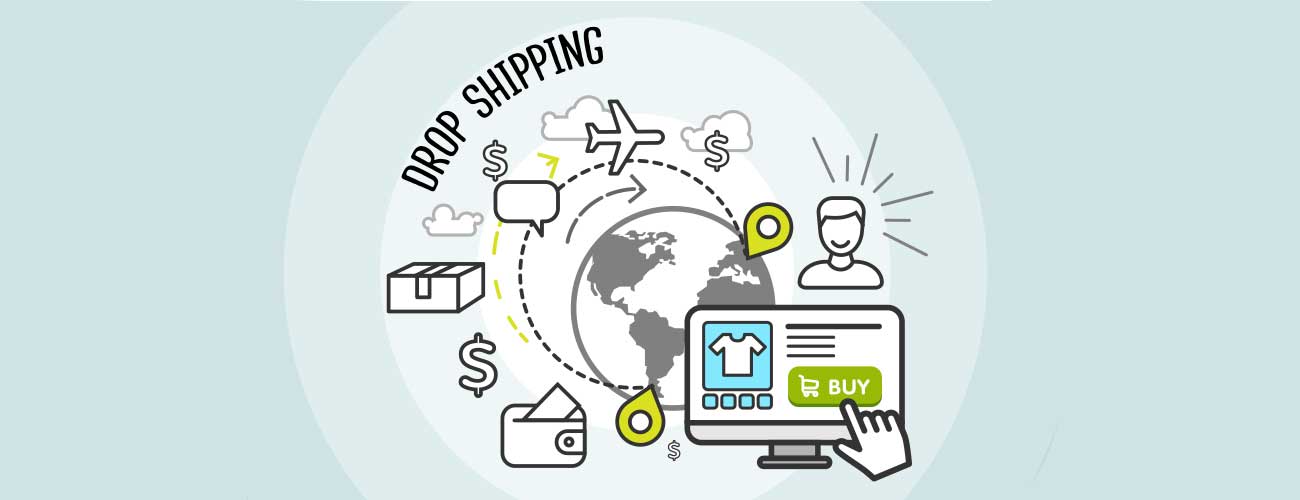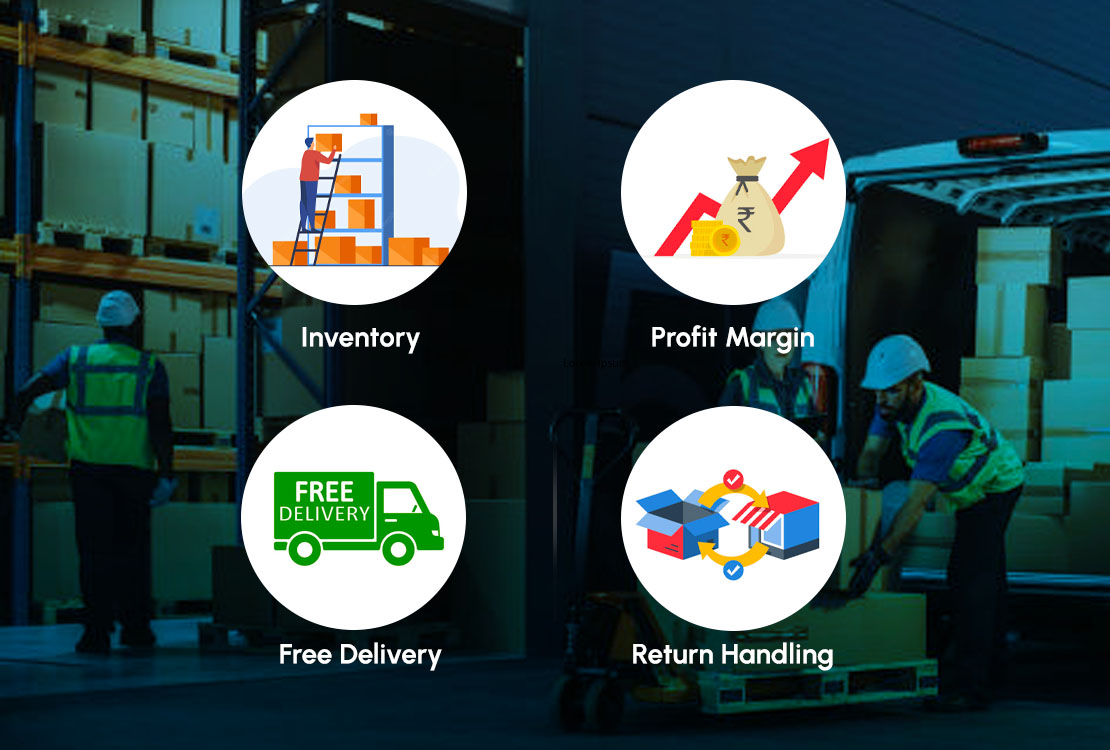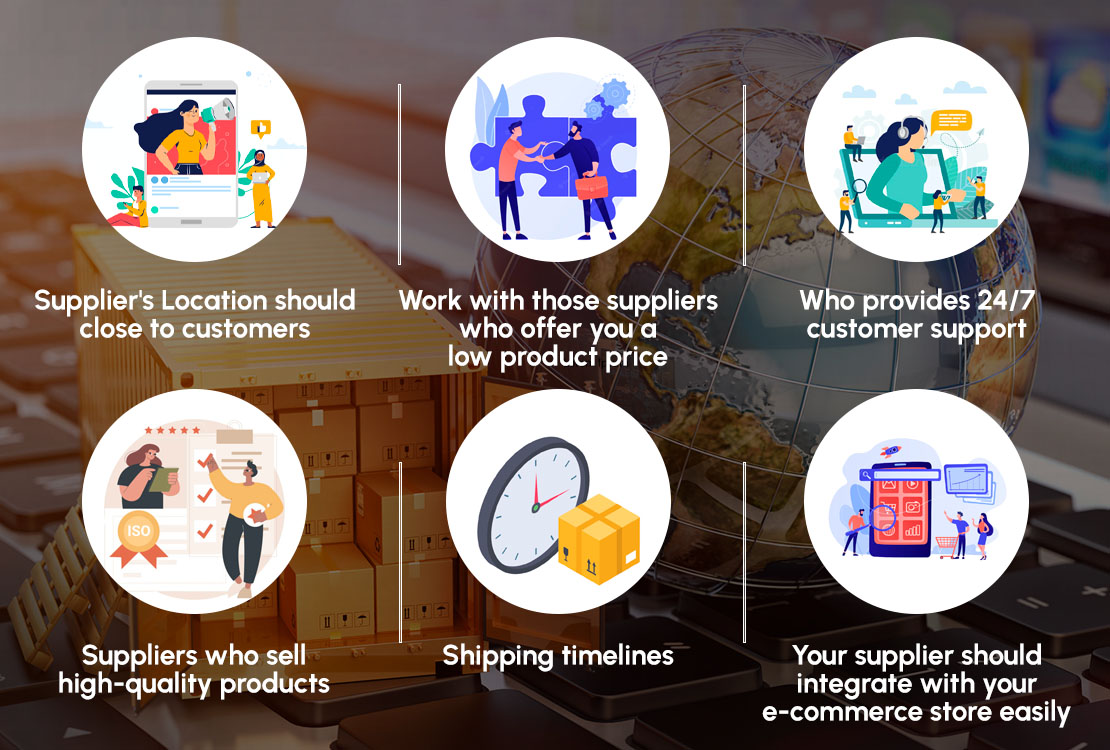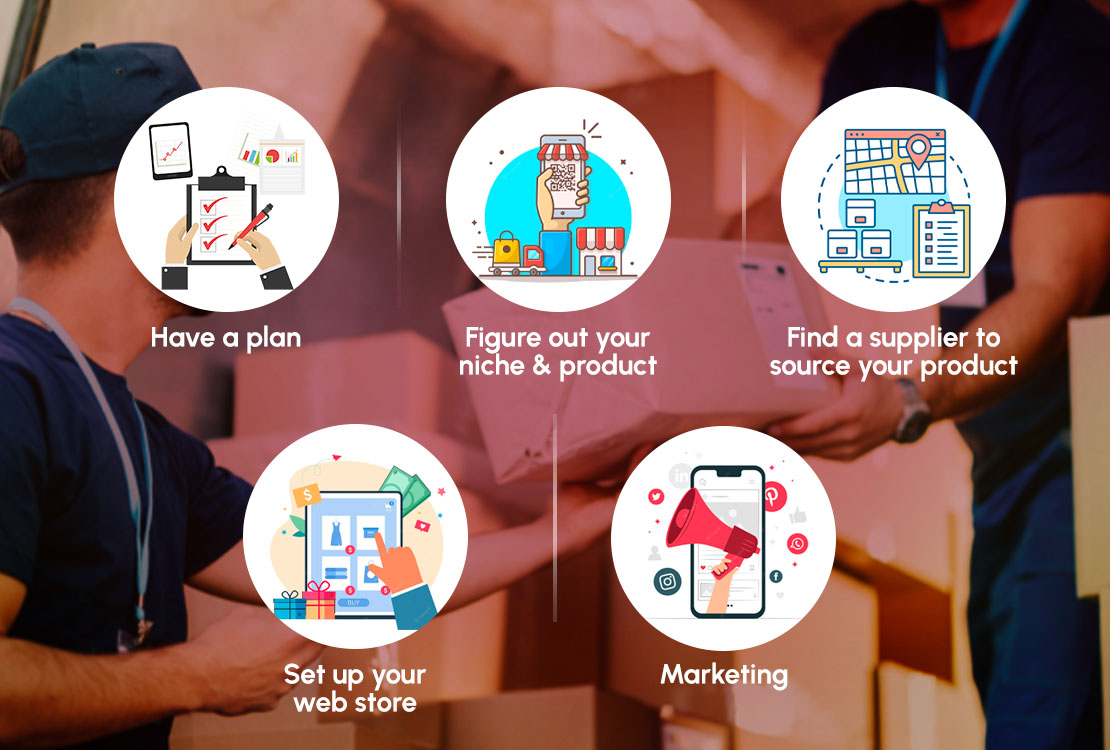There’s nothing better than making money while you’re asleep. While there are different forms of business that help you do it, eCommerce is one of the best options. Having an eCommerce business is not only a profitable option but also a wise one. For the starters, it is convenient that you sell online than sit in a retail store all day. But, what if we told you that you could sell online without any inventory? Welcome to the world of dropshipping!
You might be new to the world of online selling. Alternatively, you might have been reaching out to the audience for a while. In either of the cases, dropshipping is something that can add to your profits!
Dropshipping is a popular business model all over the world. It helps sellers reach out to their target audience through the means of their eCommerce store. In case you’re still having a hard time convincing yourself to start a dropshipping business, don’t worry! The following research is all set to blow your mind.
Statistics suggest that the global dropshipping market has grown significantly since 2018. It was evaluated at 102.2 billion in 2018 and has grown at a CAGR of 28.8% ever since. With an amazing growth rate followed by the unprecedented interest of businesses, dropshipping is taking off in eCommerce.
At this point is natural to have many questions related to dropshipping. For example, If you’re wondering what is dropshipping? Whether it is the right kind of business for you? Or Is dropshipping profitable in 2020? Don’t worry, you’re in the right place!
We’ve gone ahead and compiled all the information you need to know about dropshipping in 2020. Let’s take a look at these-
What is Dropshipping?
The idea of eCommerce sounds interesting to everyone who wants to get started with business But, as enticing as it sounds, eCommerce has challenges of its own. With dropshipping, a lot of them are addressed.
Dropshipping is one of the easiest forms of business today. Having said this, it has a few challenges of its own. But, these can be taken care of with smart strategies. Dropshipping is suitable for sellers who want to do business without much ado. It offers them a complete package of business, without the complexity involved.
Dropshipping is a type of business or more precisely an order fulfillment method. One of the most important characteristics of dropshipping is that it doesn’t require physical inventory to carry out business. In other words, businesses can go on selling products and reaching out to customers, but without the bottleneck of stocking an inventory.
The Flow of Business in Dropshipping
It might sound like a ‘get rich instantly’ kind of formula. However, dropshipping has details of its own. Instead of storing the products, a store passes on the sales order to a third party. This third party is the supplier or wholesaler that ships a product to the customer’s doorstep upon receiving the order.
Therefore, the correct flow of business would be as follows:
- The seller displays a product on their website
- The customer finds the product and places an order on the website
- The seller receives the customer’s order
- The same order is passed onto the wholesaler or supplier
- The supplier picks, packs and ships the product to the customer’s address
Once the customer receives the products, the order fulfillment chain gets completed.
Surely, dropshipping sounds hassle-free and something that everyone can do. However, starting a full-fledged in dropshipping requires a lot of effort. Undoubtedly, once it takes off there are unprecedented profits and a great reputation waiting for you.
The point is if you’re dropshipping, you will find it hard to get started in the domain. You’d need to find the right suppliers and build your own website. Alternatively, you’d have to look for a marketplace to list your products.
Once you do this, you’ll have to build your audience. Go out extensively on multiple channels and market your business. Once all the hard work is done, the comfort will come as you start receiving orders.
This is where your wholesaler will have to do their job. All you have to do is pass on the order to your supplier. Rest everything from picking, packing to shipping will be on them!


Dropshipping Fulfilment: Understanding the Supply Chain
The idea of dropshipping fulfillment can be also understood from the perspective of the supply chain. In fact, dropshipping fulfillment is a small part of the actual supply chain process. In case you’re wondering what supply chain is, don’t worry.
The supply chain is a complex process that describes the entire journey of a product. It starts from the time a good is manufactured. And then continues until it is delivered at the customer’s doorstep. When it comes to dropshipping, there are three pillars of the dropshipping supply chain. These are manufacturers, wholesalers, and retailers.
Manufacturers
Manufacturers are the people ho create the product. For example, a manufacturer is a person who builds a handicraft product from its raw materials. Moreover, manufacturers don’t directly sell the product to the end customer. Instead, they sell it to wholesalers and retailers in bulk. Because you’re directly buying from the manufacturer, the product costs would be quite less.
On the other hand, manufacturers would have a certain minimum quantity restriction on thier product. This means if you’re purchasing from a manufacturer, you might have to adhere to their minimum selling quantity. Alternatively, buying from a wholesaler is at times easier because of fewer constraints.
Wholesalers
The next category of entities in the dropshipping supply chain is the wholesalers. Wholesalers are those people who purchase the products from manufacturers. As the name suggests, a wholesaler buys products from a manufacturer in bulk. It is then that they sell these products to a retailer.
Moreover, the reason why retailers love to purchase from wholesalers is due to fewer purchase requirements. For example, as a seller, if you go to a manufacturer to purchase goods, they will ask you to buy 100 units of a product at once. On the other hand, if you go to a wholesaler, chances are they will ask you to buy only 40 such products. For this reason, if you’re starting out as a seller, it would be better to go for a wholesaler rather than a manufacturer.
However, if you are selling some custom made products, you have no option but to go to a manufacturer and negotiate the price and quantity with them.
Retailers
The final element of the dropshipping pillar are the retailers. Retailers are those sellers that sell the product directly to the end customer. For example, someone selling on a marketplace like Amazon or Flipkart is a retailer.
Moreover, if you’re running a business, where a supplier is fulfilling your orders, you’re in a dropshipping business.
Dropshipping as a Service in the Supply Chain
If you’re been probably assuming dropshipping as a role, you’re mistaken. It is a service rather than something you can attribute as a role. This is because regardless of what your business type is, any of the three pillars of your business can act as a dropshipper.
It can be your manufacturer, the wholesaler or infact the retailer. For example, if your manufacturer directly fulfills the product to your customers, they can be the dropshipper. Alternatively, if it is a retailer shipping products to your customer’s doorsteps, they can be a dropshipper too.
Therefore, just because someone selling goods claims to be a dropshipper, doesn’t mean you’ll get the benefit of lucrative prices. While the margin is considerably good in the case of a manufacturer, it comes down for a retailer.
Make sure you research well on the prices before settling in as a dropshipper. And it’s obviously better to opt for a manufacturer and wholesaler rather than a retailer.
What do I Need to Know Before Dropshipping?
Now that you know about the tiers of dropshipping, let’s move on to understanding the essentials of the business. While lucrative profits might lure you into getting started instantly, it is better that you know about the pros and cons of dropshipping in a better manner.
This will help you out your best foot forward in the market without having to doubt every decision you make. Alternatively. If you’re new to the world of business, everything about it can seem overwhelming. Right from finding the right dropshipping products to choosing the right supplier and more.
It’s best that you know everything before you get started. This will help you avoid the roadblocks in your way. Take a look at the key points below-
Be Precise About Your Delivery Date
Most of the dropshippers get too excited about dropshipping and immediately start mentioning that they deliver worldwide. While taking your business to the world is interesting, it is however, not a good option to mention shipping times that seem unreasonable. Just because you know that Aliexpress will deliver almost anything to any country, it doesn’t mean you stop paying attention.
While your supplier might be delivering to both the USA and UK, their estimated delivery time is bound to vary. It might be 20 days for the UK, while only 10 days for the US. Therefore, if you just mention 10 days for all your customers across different countries, it will damage your reputation directly. And this is because your supplier will not be able to deliver to every country in 10 days, ultimately damaging your reputation.
Therefore, be specific about your shipping time estimates. After all, it’s your business’ name that the customer will remember.
Be Careful While Dropshipping on Amazon
As an online seller, one of your biggest dreams might be selling on Amazon. No doubt selling on Amazon is a lucrative business opportunity. But, When you’re dropshipping this can be a little difficult.
That’s because when you’re selling online as a dropshipper, your deliveries are dependent on your manufacturer or wholesaler. This leaves you with a little room to go ahead and make huge claims about it.
In other words, Dropshipping on Amazon, eBay and other such platforms means catering to the demands of customers more rapidly. Customers purchase from these marketplaces because they get their product delivered within one or two days. As a dropshipper that might be difficult for you.
And that’s because once you receive an order, you have to pass down the same to your supplier. Once you do so, the supplier will pick up the inventory, then go onto packing and shipping it. Moreover, the geographical area of their warehouse and shipping partner will decide how much the speed at which the order reaches the customer’s doorsteps. This entire process might end up taking a lot of time.
Amazon customers on the other hand, want speedy deliveries and quick returns. Therefore, if you happen to dropship where your supplier is too far from your customer’s location, it might not make much sense. On the other hand, if you have a supplier in your locality, you can go on and deliver in an expedited manner, you can easily sell on Amazon.
Setting Up a Company
If you think that you have to establish an elaborate business before starting dropshipping, it doesn’t have to be this way. You don’t need to establish a full-fledged LLC if you plan to sell online a dropshipper. In fact, anybody can start selling online.
This is also one of the most asked questions by people planning to establish their dropshipping business. However, the answer to this question is simply no- you don’t need any paperwork to set up your dropshipping company and start selling online.
Alternatively, some marketplaces or shipping courier services might ask you for a GSTIN number as it is required by the government norms to sell anything in India. But, this is nly to register yourself as a seller. Moreover, it doesn’t mean that you have to register as a company anywhere.
The idea is that if you don’t register as a company, firm or partnership, you are by default a sole proprietorship. While registering as a full-fledged company has its pros and saves you from any legal trouble, its okay to start as a sole proprietor.
Refund Policy
One of the most important aspects of the eCommerce business is a refund policy. While nobody likes to receive a return package, the fact is that they are inevitable in eCommerce. Moreover, they play a huge role in the purchase decision of your buyer. Therefore, if you want customers to purchase from your brand, you have to create a robust refund policy.
Make returns free and completely covered. This would send across a message that your brand is completely transparent with nothing to hide. Moreover, this will direct purchases and make customer decisions impacted by your brand.
A robust refund policy also guarantees that you are protected against any claims of chargebacks and disputes. It is a page where you can clearly mention which of the items are available for returns and which ones are not.
Make sure that you protect your business against fraud customers or buyers who look for an excuse to return the product. While at the same time, you also make your customers feel that you are doing a transparent business and they can return a product if it’s broken or damaged.
How to Find and Work with Dropshipping Suppliers and Wholesalers?
As you move onto purchasing from a supplier such as a manufacturer or a wholesaler it becomes important to make sure that they are authentic. After all, you won’t want to lose all your money on someone who doesn’t deliver to your customers on time. Moreover, some suppliers might not provide quality products, leading to eCommerce returns. Therefore, be aware about your supplier and their whereabouts.
It is naturally observed that legitimate suppliers are difficult to find because they don’t market themselves well. They could be a small household or someone manufacturing items since deceased but doing it silently. Try to filter out the crowd before you move onto making a purchase decision.
Check out for the following factors before making purchase with a supplier-
Ongoing fee
When finding a supplier, you might find that some charge a monthly fee or an ongoing fee. They claim that they are charging it as a fee of doing business with you. Ideally, an authentic supplier never asks for any such fee, so if someone does, it’s a red flag.
In another instance, people who charge you a monthly fee might be supplier directories instead of suppliers themselves. Supplier directories are those that provide you a list of suppliers in a particular market. They may also help you find the supplier depending on the product category.
Directly Selling to the End Customer
Some suppliers also sell to the end customer. Therefore, when you approach them, you might have to prove that you are a legitimate seller and you are not cheating your audience. Approach them with a wholesale discount as you plan to purchase large quantities of products from them.
Order Fee
A lot of manufacturers and wholesalers will charge you a fee for every order they are required to ship at the customers’ doorstep. It usually depends on the complexity of the product, the packaging requirements and the shipping distance. These per order fees are usually flat as per the industry standards.
Minimum Size of Your Order
Since the point of dropshipping is to purchase in bulk, your supplier might ask you for a minimum number of quantities to be shipped. This isn’t a reason to assume that the supplier is fake. It is just a guarantee for the prices you are negotiating for a product. This practice helps secure the suppliers interest since they might not be interested in a short term or window shopping merchant.
Reach Out to the Manufacturer
The point is you’ll have to reach out to a supplier before you establish an online presence and reach out to your customers. In the process, you might have to use extensive tools and search methodologies. This will ensure that you find the right supplier for your product category.
You can do it in many ways. For example, you can contact a manufacturer and then ask them about local distributors. Once you get their information, you can reach out to them and ask if they would be interested in dropshipping. Alternatively, you can use some of the techniques below-
- Order from your competition
- Conduct an extensive search using Google
- Look up for a supplier in the directory
- Ask local retailers about their wholesalers
- Be a part of online Facebook seller discussion forums
- Attend a trade fair and get in touch with potential suppliers’
What is the Order Process in Dropshipping?
The order process in dropshipping is slightly different than traditional commerce. In other words, while everything appears the same on the customer’s end, it is entirely different at the sellers’ end. For example, the process process goes through two key people at the seller’s end before it is delivered to the customer
Let us start from the time that an order is placed via customer’s smart phone. Whether you’re selling on your website or marketplace, a customer will place an order online. This is where the process of dropshinng will start.
Step 1: Customer Places an Order on Store X
Suppose that you are running a store X with a range of products. You have ads targeted to the customers on different platforms such as Facebook, Instagram etc. One of the customers interested in the products you sell, finds your brand online and reaches your store X. They place an order for a product.
As an online seller you will send a notification of order confirmation to your customers’ email id or phone number. This is usually done using the transaction emails and can be quickly set up automatically.
The payment for the product is either captured by the payment gateway on your website and deposited into your account. Alter, if the customer opts for a cash on delivery method, the courier agent delivering the products will collect it from the customer.
Step 2: Store X will Place an Order with the Supplier
Once the customer places an order with store X, you have to forward the same to your supplier. This is because in dropshipping you don’t hold any direct inventory. Therefore, you place an order with your supplier.
This is usually done through a well-established store or email mechanism in place. Once your supplier receives a prompt for an order, their activities are set to motion. Depending upon your agreement, your supplier will have an order forwarding process in place. It means you can agree to use an inventory management system or a webstore, where an admin and vendors are assigned below them.
Step 3: Your Wholesaler Ships the Order
Upon receiving the order form Store X, the supplier starts the next chain of activities. This means picking, packing and shipping the product. The supplier picks the product, performs a quality check on it. They also study the number of units ordered by the customer and whether there are any special requests such as two or more products might be clubbed and sold together.
Once the picking is done, the product moves onto the packaging phase. This is where it is packed in primary packaging material and tertiary packaging material. Then the supplier assigns the parcel to the right courier service depending upon the region and cost of delivery to the customer’s place.
Since wholesalers deal with a lot of orders everyday, they get started with their part of the job instantly. This means, a product can be picked, packed and shipped within hours.
Before shipping, one of the most important aspects of the package turns out to be the shipping label. As the product is packed by the supplier they also print out the shipping label and stick it to the package.
This shipping label has the name, brand logo and details of Store X. And that is because the customer initially ordered it from the store X itself.
Step 4: Sending Tracking Information
After the supplier’s job has been finished, the process returns back to Store X. The job of the store X is to provide tracking information to the customer over the email, phone or via a notification. Once the order gets delivered to the customer’s doorstep, the fulfilment phase gets completed.
The share of the supplier is handed over by Store X.The additional income collected by the Store X is their profit.
How to Start Dropshipping? How to Start a Dropshipping Company?
Now that you are aware about the dropshipping process completely, we can move forward. It is best that you proceed to understanding the steps you need to take to start a dropshipping business. This will help you plan your endeavours and get started with online selling without any difficulty.
Invest Time
The first step towards setting up your dropshipping business is to invest your time in it. Investing time is fundamental to your business as well as knowing the broader aspects of your business. Moreover, unless you invest time, you can’t find profitable product ideas, good suppliers, website solutions etc.
Therefore, put some time in deciding the business model, what will be your approach to it, especially if you’re a first time dropshipper. With this you will learn the following-
- How to establish a business online?
- What are the mistakes to avoid as a first time dropshipper?
- How to operate a business inside, out?
- How to realize projects that are worth spending the money on?
- What are the markets and what are the personas of your customers?
Most people get too excited with the idea of shipping that they enter the market in a haste. These sellers overlook a lot of things and end up quitting in the first six months. By investing time, you are ensuring that none of this happens to your business.
Invest Money
After you invest your time and you’re surpe about dropshipping is something you want to do, you’ll have to invest money. Investing money can mean setting up your website, or paying some minimum selling fee to establish your presence on a marketplace.
If you plan to completely outsource your activities, it is best that you first do everything yourself. This will give you an idea of what the business is and how you can improve it. If it is your first time in a dropshipping business, it is best that you participate in most of the activities by yourself.
This is because if you don’t understand your business, you will always be easily convinced by vendos, developers, coders etc. who manage the business for you. While a certain amount of investment is needed to start a business, it is minimum and also depends on the product category you want to sell.
Decide on Your Business Structure
What kind of business do you want to start? While dropshipping is your primary business model, you need to set up a legitimate business structure. This is crucial in reaching out to customers as well as partnering with suppliers. Some quality suppliers ask for a proper registration if your business to make sure it is authentic.
Here are some of the types of business you can register for-
Sole Proprietorship
This is the kind of business when you’re alone running your company. Alternatively, if you don’t register for any business, you’ll be called a sole proprietor.
LLC or Limited Liability Company
The next category of company is LLC. This means a Limited Liability Company. This type of company offers you the protection against your personal and business assets by establishing you as a legal entity. There aren’t many filing requirements but you get to protect yourself against unwanted claims, payment issues and more if you’re registered as an LLC.
Joint Corporation
Chances might be that you are running a business with a partner. This way you are not the sole owner of the business. Therefore, the registration norms, takes ivolves and others have to be distributed with the stakeholders which are you and your partner.
Register for a GSTIN
Online selling in India has to be marked via a GSTIN number. It is the Indian government’s guidelines that sellers have to register for a GSTIN before they start selling. GSTIN is something you have to present while filing for taxes and more. Moreover, if you are partnering with a shipping service or logistics platform, a GSTIN number might be considered mandatory.
Partner with a Supplier and Shipping Company
The last part of the dropshipping process is to partner with a shipping company or a supplier. While we have already talked about finding the right suppliers for dropshipping, let’s move on. You might also want to partner with a logistics platform for cheaper shipping rates and more.
This will help you and your supplier streamline the logistics activities and concentrate on more business critical decisions. One of the best shipping companies to partner with is Dash101. Using the platform you get the lowest shipping rates starting at Rs 23/500 gms, and get to ship with 7+ courier partners.


Getting Started with Dropshipping on Amazon and eBay
You might have decided on the dropshipping business model, picked the right supplier, partnered with a courier company and more. But, unless you choose your sales channel, nothing makes sense.
Amazon and eBay can be excellent for dropshipping. Alternatively, it can also be a platform to reach out to your buyers across the world. But, you must be careful about some factors, before you start selling on these platforms-
Dropshipping on Amazon
Amazon is indeed one of the greatest selling e commerce marketplaces out there. This means that it already has a large customer base established. By adding your products to the platform, you are leveraging its extensive reach and gaining visibility.
Pros of selling on Amazon
Additionally, the platform is easy to get started with. It doesn’t require any investment and you can have immediate access to the market from anywhere. Moreover, if you are struggling with fulfilment and shipping requirements, Amazon has a solution for you.
Amazon offers fulfilment services known as Fulfilment by Amazon where your products are stores, picked and packed by Amazon itself. In case you find it difficult to ship with your supplier, you can simply purchase the products and hand them over to the FBA for fulfilment. No doubt, there is a selling fee for it, but if your profit margins are good enough, you can opt for this.
Cons of Selling on Amazon
There are also several cons of shipping on Amazon. Amazon charges a lot of selling fees. These depend on product categories but also constitute a huge commission. If you’re new to the business, it might seem like too much to give away your money like that. Moreover, there are no customization options on Amazon. You are bound to their rules and regulations and have no space to make decisions about anything else but price.
Dropshipping on eBay
Similar to Amazon, you can also start shipping on eBay. eBay is a popular marketplace that is known not just in India but also across the world. When you’re selling on eBay, you open your business to a lot of possibilities. For example, since the marketplace already has a well-established business reach, you can start dropshipping on eBay instantly.
Pros of Selling on eBay
Moreover, when you are dropshipping on eBay you don’t have to worry about the marketing efforts. Marketplaces like ebay promote the product for you by themselves and provide you a bigger opportunity to reach out to your audience.
Cons of selling on eBay
In a similar fashion to Amazon, eBay too has cons. It charges you a heavy selling fee. They charge as much as 10 percent of the success fee which is too much as compared to product profits. Moreover, you cannot form long term partnerships with the customers as they are bound by the name of eBay.
There is also a risk of your business data being exposed since everything you do is being tracked down by the platform. You are restricted in how you can communicate with your seller and you are not building any permanent assets for yourself. Even if you might be providing your customers with an unparalleled experience, chances are nobody will remember your brand.
Is Dropshipping Still Profitable in 2020?
Dropshipping might seem like one of the best business opportunities in the market. However, there are a few things that you need to stay careful about. Often small businesses are too drawn with the idea of earning profits, that they overlook the tiny details of business. This not only spoils the customer experience but also leaves them with no profit margins.
It is always important to remember that it is your reputation at stake when you dropship anything online. Your supplier might be fulfilling the orders but, it is ultimately your brand from which the customer is ordering. So, if anything goes wrong, they’ll directly come to you and talk about your brand on online platforms such as social media.
The Pros and Cons of Dropshipping
You might have seen the marketing efforts of brands going to waste due to ruined customer experience. For example, when brands post on social media, customers who have faced negligence can’t stop but complaining in the comments section. Therefore, not only leaves a bad impression but also destroys your marketing efforts since new customers are reading it.
Therefore, if you are dropshipping, make sure you put your 100 percent in the business. Some new sellers completely outsource their business, putting it in jeopardy. In spite of the investment, they are not able to earn a good name from this process.
For example, since of the factors that slow down the pace of a dropshipping business are-
- High cost of products
- Too high shipping costs
- Low product quality
- No customer support
- Lack of a proper refund policy
- Suppliers not adhering to their fulfilment duties
Now when it comes to 2020, you might ask whether dropshipping is at all a good idea. Let me go ahead and start by saying that eCommerce has been on a rise like never before. The trajectory of the eCommerce industry is growing like never before. Moreover, people are embracing eCommerce.
In addition to this, the situation of the pandemic has made people prefer online shopping rather than going out to a retail store. So, if you have the right products in mind, you can dropshipping without any fear.
Some of the best reasons why dropshipping makes sense in 2020 is because-
- More suppliers are understanding the concept of drop shipping and partnering with providers to cater to the customers’ needs.
- Sending payments online has become easier than ever. Customers trust secure payment gateways such wallets, etc.
- With no upfront payment, dropshipping makes for a good business opportunity.
- There is no constraint of having an inventory, therefore, easy business.
Conclusion
Dropshipping can be a good business opportunity if you have the right partners to get started with. There are several businesses that have risen to fame with lucrative dropshipping opportunities.
Figure out how much money you are estimating to get out of the business and then take a look at the number of products you will have to sell for the same. Then break down the costs into profits, supplier charges, shipping fee etc.
A lot of your dropshipping troubles can be put to rest if you are shipping via trusted logistics platform. One such option is Dash101, where you can ship hassle-free and deliver to more than 26000+ Pn codes. This means you will not just get profits but also a superior customer experience, which will make your customers come back for more.






Leave a Review